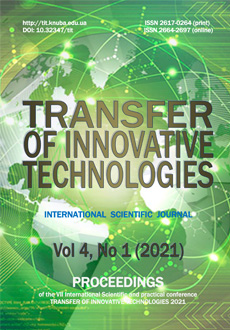Improvement of crane-manipulator equipment for emergency rescue and restoration works
DOI:
https://doi.org/10.32347/tit2141.0202Keywords:
emergency rescue and restoration works, crane-manipulator equipmentAbstract
To implement state policy in the fields of civil protection, protection of the population and territories from emergencies and their prevention, emergency response, rescue, fire fighting, fire and man-made safety, emergency services, as well as hydrometeorological activities There is the State Service of Ukraine for Emergencies (hereinafter SES of Ukraine) [1]. 7 emergency rescue formations (central subordination), including aviation, are subordinated to it; 25 emergency rescue teams of special purpose and 1182 district fire and rescue units (territorial subordination) [2].
According to the main capabilities of the units of the Rescue Service of Civil Defense are divided into:
1) units intended for extinguishing fires, rescuing people and property in case of fires, at facilities and territories, regardless of subordination and form of ownership, conducting emergency rescue operations, providing primary medical care to victims.
2) formation (detachments, centers) designed to eliminate accidents (catastrophes) of technogenic, natural and military nature, the consequences of natural disasters (earthquakes, storms, landslides, landslides, mudslides, floods, snow snowdrifts, icing, etc.), search and rescue, fire and rescue operations, international rescue operations, demining activities and civil and territorial defense measures, national and regional in nature.
They include:
- fire and rescue units - for firefighting, rescue of people and property at facilities and territories, regardless of subordination and form of ownership. - rescue units - designed to deploy and carry out rescue and other urgent work in the shortest possible time, to search (including the use of service dogs) and rescue people who are in destroyed, burning buildings, under the rubble, including excavation of victims from collapsed buildings, as well as to provide first aid to victims;
- engineering - for conducting engineering reconnaissance of routes and centers of destruction, clearing of blockages, excavation of victims from under the damaged constructions, creation of special passages in blockages, collapse of designs, detection of damages in utility and energy and technological networks, preparation and maintenance of roads, formation of fencing anti-fire lanes;
- radiation and chemical protection - conduct radiation and chemical reconnaissance, carry out dosimetric and chemical control of units, perform degassing, decontamination of uniforms and other material means, areas, roads and structures;
- pyrotechnic - detect and destroy unused ammunition, including aircraft bombs and other explosive devices, neutralize the affected structural elements of buildings and houses, as well as pierce passages in the rubble by explosive methods;
--water supply - designed for the development of water sources and equipment of water supply points;
- communication - to establish and maintain reliable communication, which provides communication between departments, governing bodies and various forces of interaction;
- material support - must timely meet the urgent needs of units with special equipment, fuel, products, protective equipment, clothing, medical, technical property and other material means.
Units of the SES of Ukraine have at their disposal a significant amount of equipment, which can be divided, depending on its functionality and purpose for fire and rescue vehicles, vehicles for special work in emergencies and special cars. [3] Of the self-propelled vehicles for emergency response, wheeled vehicles for all types of work have become the most widespread.
References
https://uk.wikipedia.org/wiki/Державна_служба_України_з_надзвичайних_ситуацій
Гащук П.М., Сичевський М.І. (2015). Особливості й труднощі класифікації само-хідної техніки для ліквідації надзвичайних ситуацій. Пожежна безпека: збірник наук. праць ЛДУ БЖД, 27, 33-43.
Гащук П.М., Сичевський М.І. (2016). Загальні світові тенденції в царині проектування й виготовлення мобільної пожежно-рятувальної техніки. Північна Америкаю. Пожежна безпека: збірник наук. праць ЛДУ БЖД, 29, 18-35.
Михайло Сукач, Анатолій Кравчук (2020). Тенденції збільшення прохідності та без-пеки машин (на прикладі бронеавтомобі-лів армії США). Гірн., буд., дор. та меліо-рат. машини, Вип.95, 25-40
https://doi.org/10.32347/gbdmm2020.95.0202
https://www.magirusgroup.com/de/en/home
Пожежні автомобілі для пожежогасін-ня та проведення рятувальних робіт. Тех-нічні вимоги https://www.dsns.gov.ua/files/2021/2/11/3/%D0%A2%D0%B5%D1%85%D0%BD%D1%96%D1%87%D0%BD%D1%96%20%D0%B2%D0%B8%D0%BC%D0%BE%D0%B3%D0%B8%202021.pdf/
https://thk.kiev.ua/about, https://thk.kiev.ua/product/avarijno-remontnaja-masterskaja-s-platformoj-i-kmu.
Downloads
Published
How to Cite
Issue
Section
License

This work is licensed under a Creative Commons Attribution-NonCommercial-NoDerivatives 4.0 International License.
Our journal abides by the CREATIVE COMMONS copyright rights and permissions for open access journals.
Authors, who are published in this journal, agree to the following conditions:
1. The authors reserve the right to authorship of the work and pass the first publication right of this work to the journal under the terms of a Creative Commons Attribution License, which allows others to freely distribute the published research with the obligatory reference to the authors of the original work and the first publication of the work in this journal.
2. The authors have the right to conclude separate supplement agreements that relate to non-exclusive work distribution in the form in which it has been published by the journal (for example, to upload the work to the online storage of the journal or publish it as part of a monograph), provided that the reference to the first publication of the work in this journal is included.




